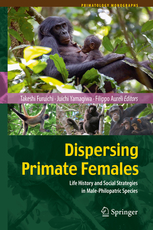



|
TOPICS BONOBO Chimpanzee "Ai" Crania photos Itani Jun'ichiro archives Open datasets for behavioral analysis Guidelines for Care and Use of Nonhuman Primates(pdf) Study material catalogue/database Guideline for field research of non-human primates 2019(pdf) Primate Genome DB 
Primate Research Institute, Kyoto University Copyright (c) |
Japanese Dispersing Primate Females
Life History and Social Strategies in Male-Philopatric Species Editors: Furuichi, Takeshi, Yamagiwa, Juichi, Aureli, Filippo
About this book
Why do females in male-philopatric species seem to show larger variation in their life history strategies than males in female-philopatric species? Why did females in human societies come to show enormous variation in the patterns of marriage, residence and mating activities? To tackle these important questions, this book presents the latest knowledge about the dispersing females in male-philopatric non-human primates and in human societies. The non-human primates that are covered include muriquis, spider monkeys, woolly monkeys, gorillas, chimpanzees, bonobos and some species of colobine monkeys. In these non-human primate species females typically leave their natal group before sexual maturation and start reproduction in other groups into which they immigrate. However, there is a large variation as some females may breed in their natal group with some risks of inbreeding with their male relatives and some females may associate with males of multiple groups at the same time after leaving their natal group. Such variation seems to provide better strategies for reproduction depending on local circumstances. Although knowledge about female dispersal patterns and life history is indispensable for understanding the dynamic structure of primate societies, it is still not known how females behave after leaving their natal groups, how many groups they visit before finally settling down and which kinds of groups they choose to immigrate into, due to the large variation and flexibility and the difficulty of tracking females after natal dispersal. To encourage further progress in this important field, this volume provides new insights on evolution of female dispersal by describing factors influencing variations in the dispersal pattern across primates and a hypothesis for the formation of human families from the perspectives of female life history. This book is recommended reading for researchers and students in primatology, anthropology, animal behavior and evolution and for anyone interested in primate societies and human evolution.  Table of contents
Dispersal Patterns of Female Northern Muriquis: Implications for Social
Dynamics, Life History, and Conservation Association Networks and Life History of Female Spider Monkeys Social Interactions and Proximal Spacing in Woolly Monkeys: Lonely Females
Looking for Male Friends Dispersal Patterns of Females in the Genus Gorilla Sex Differences in Ranging and Association Patterns in Chimpanzees in
Comparison with Bonobos Intergroup Transfer of Females and Social Relationships Between Immigrants
and Residents in Bonobo Human Female Dispersal and Social Organization: A Case of Central African
Hunter-Gatherers Life History and Sexual Relationships of Female Kalahari Hunter-Gatherers Complexities of Understanding Female Dispersal in Primates Factors Influencing Grooming Social Networks: Insights from Comparisons of
Colobines with Different Dispersal Patterns Evolution of Hominid Life History Strategy and Origin of Human Family Bibliographic information 2015/08/24 Primate Research Institute
|